Back to blog
4 MIN READ
How To Conduct Effective Customer Retention Analysis
PUBLISHED
18 January, 2024

Product Analytics Expert
Customer retention analysis gives you a much-needed window into the drivers of retention and churn.
In this guide, we’ll be sharing our tried-and-tested strategies for conducting effective customer retention analyses. We’ll cover the importance of customer retention, key action points for conducting analyses, and give you a step-by-step guide to analyzing retention data using our platform. Why listen to us?
Our leading mobile app analytics platform has helped helped brands like Costa Coffee and Recora boost product adoption and retention by solving real user issues with data-driven insights. The point is—we know just how impactful user insights can be in driving retention.
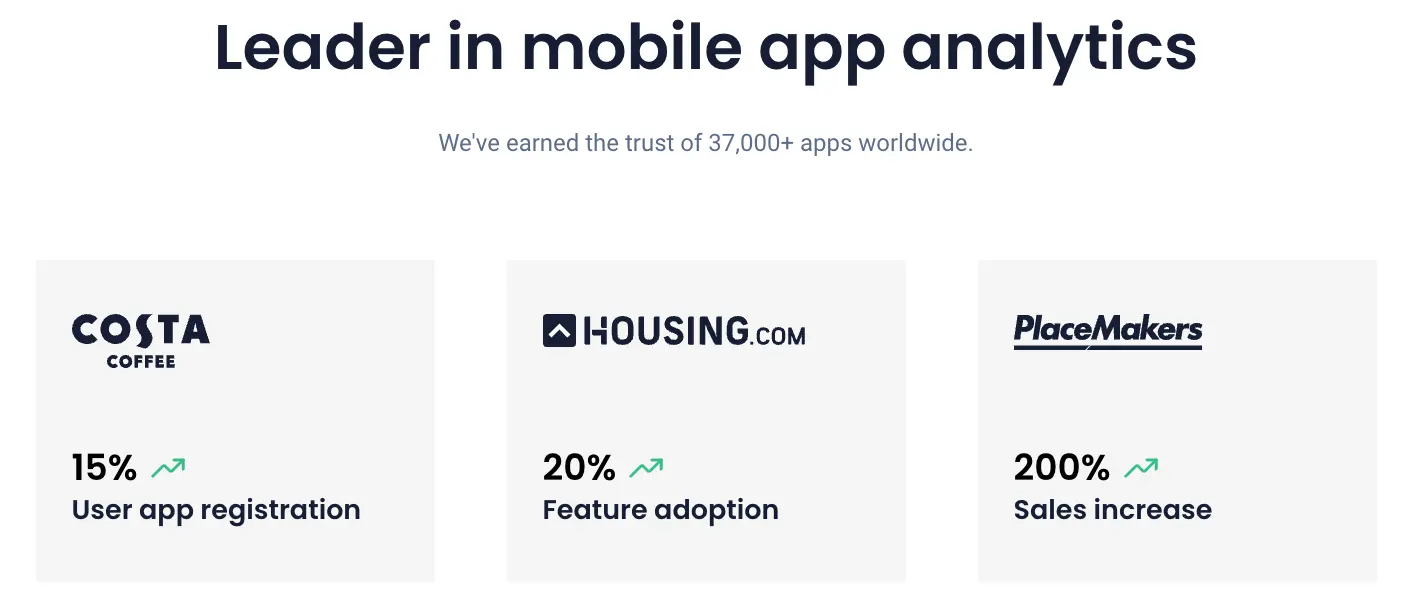
Now, let’s dive in.
Helpful summary
Overview: This article will provide insight into our approach to conducting detailed customer retention analyses.
Why you can trust us: Our method has been battle-tested by thousands of product teams worldwide.
Why it matters: Effective customer retention analytics helps in creating personalized experiences, improving engagement, and increasing profitability.
Action points: We recommend gathering data on user interactions, segmenting user groups, tracking user group behavior over time, and analyzing retention and churn rates.
Further research: Check our guide to the top customer retention management tools for in-depth reviews and comparisons.
What is a customer retention analysis?
Customer retention analysis is the systematic process of identifying, tracking, and evaluating key metrics that reflect customer loyalty over time. It provides insights into app features which engage users the most, helps predict customer behavior, and throws light on improvement areas for causing a reduction in user churn.
There isn’t one way to conduct a customer retention analysis—instead, there are multiple techniques and methods that can be used:
Cohort analysis
Retention dashboards
Session replays and heatmaps
Event analytics
… and more.
Why is customer retention analysis important?
Increased revenue
In general, you have a 60-70% chance of selling to an existing customer and a 5-20% chance of selling to a new customer. Focusing on retaining customers is a very effective way to boost your revenue while keeping your marketing and acquisition costs low.
Improved customer satisfaction
Retention generally improves when your customers are happy—and vice versa. By analyzing customer retention, you can identify areas where customers may be dissatisfied or dropping off, allowing you to make necessary changes and improvements to keep them satisfied.
Better understanding of customer behavior
Retention analysis will also likely reveal other insights into user behavior beyond just retention rates. You can track usage patterns, identify popular features or products, and gain a better understanding of your target audience's preferences and needs.
How to conduct a comprehensive retention analysis with UXCam
Set up retention analytics
Examine user flows
Segment your customer base
Conduct surveys and gather feedback
Now let's dive deep into each step.
1. Set up retention analytics
Setting up retention analytics with UXCam’s SDK is as simple as installing a single code snippet into your app. Once the code is embedded, UXCam will automatically track every user interaction using tagless autocapture technology.
To access our dedicated retention analytics feature, navigate to the ‘Retention’ tab.
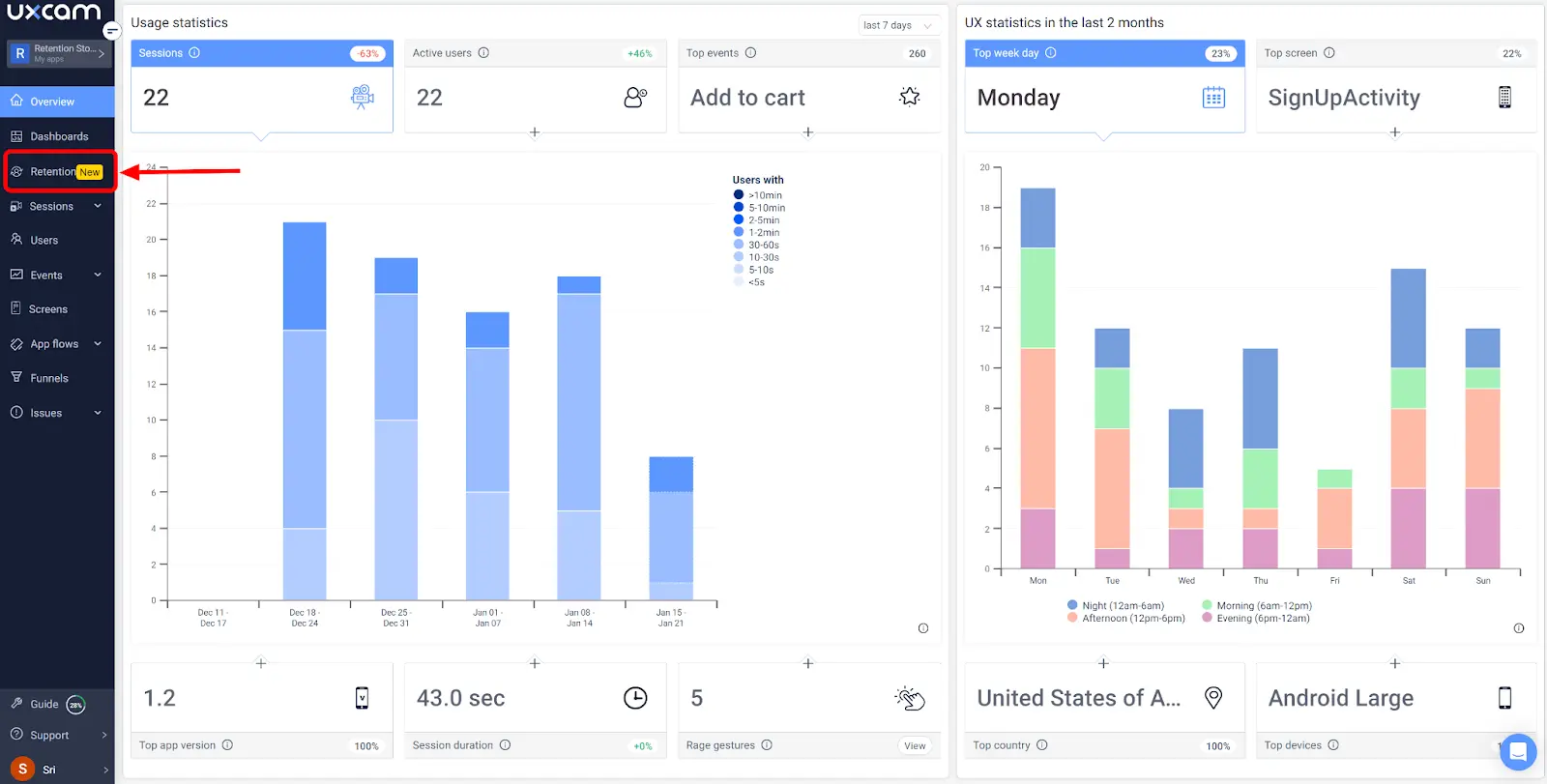
There, you’ll be able to create customizable retention reports that offer week-by-week insights into retention rates.
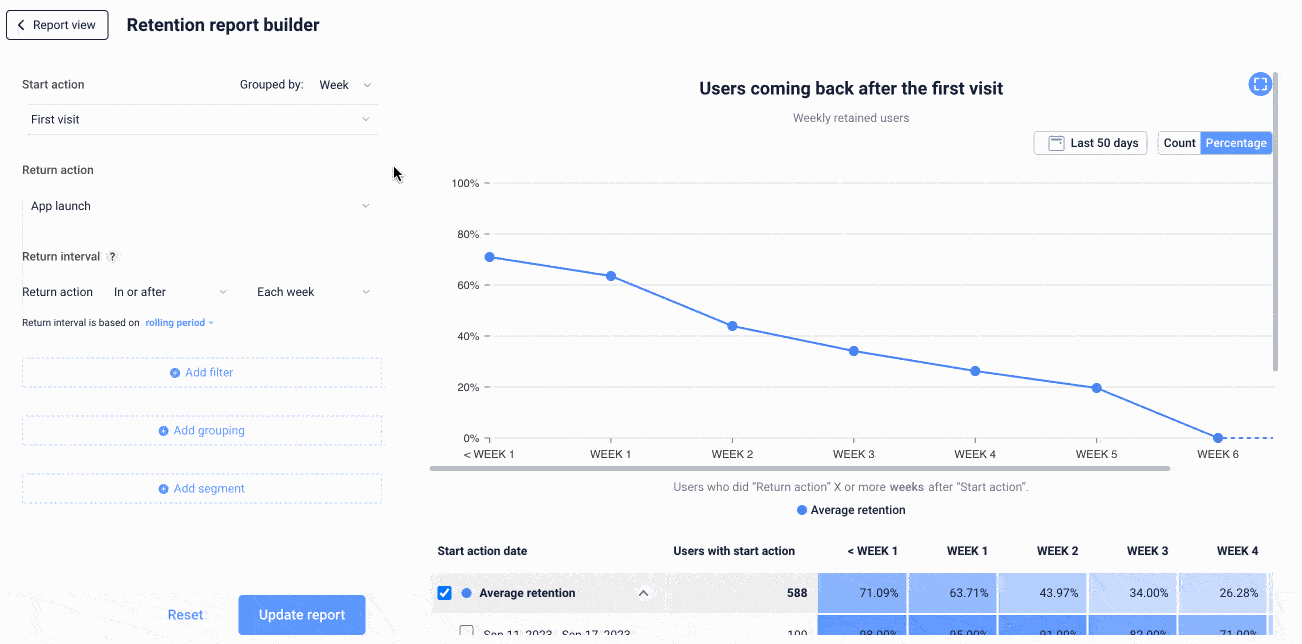
To maximize the value of these reports and yield deeper insights, you can:
Specify start and return actions
Specify return intervals
Add filters, groupings, and segments
Compare cohorts
We’ll talk more about these higher-level features below. Even without them, the basic retention report will give you valuable insights into things like when users stop finding value in your app and when they churn.
2. Examine user flows
In addition to UXCam’s dedicated retention feature, our platform also allows you to view detailed user flows using:
Screen flows
Screen bursts
These are powerful tools for retention analysis because they allow you to see which paths through your app lead to the best (and worst) user outcomes.
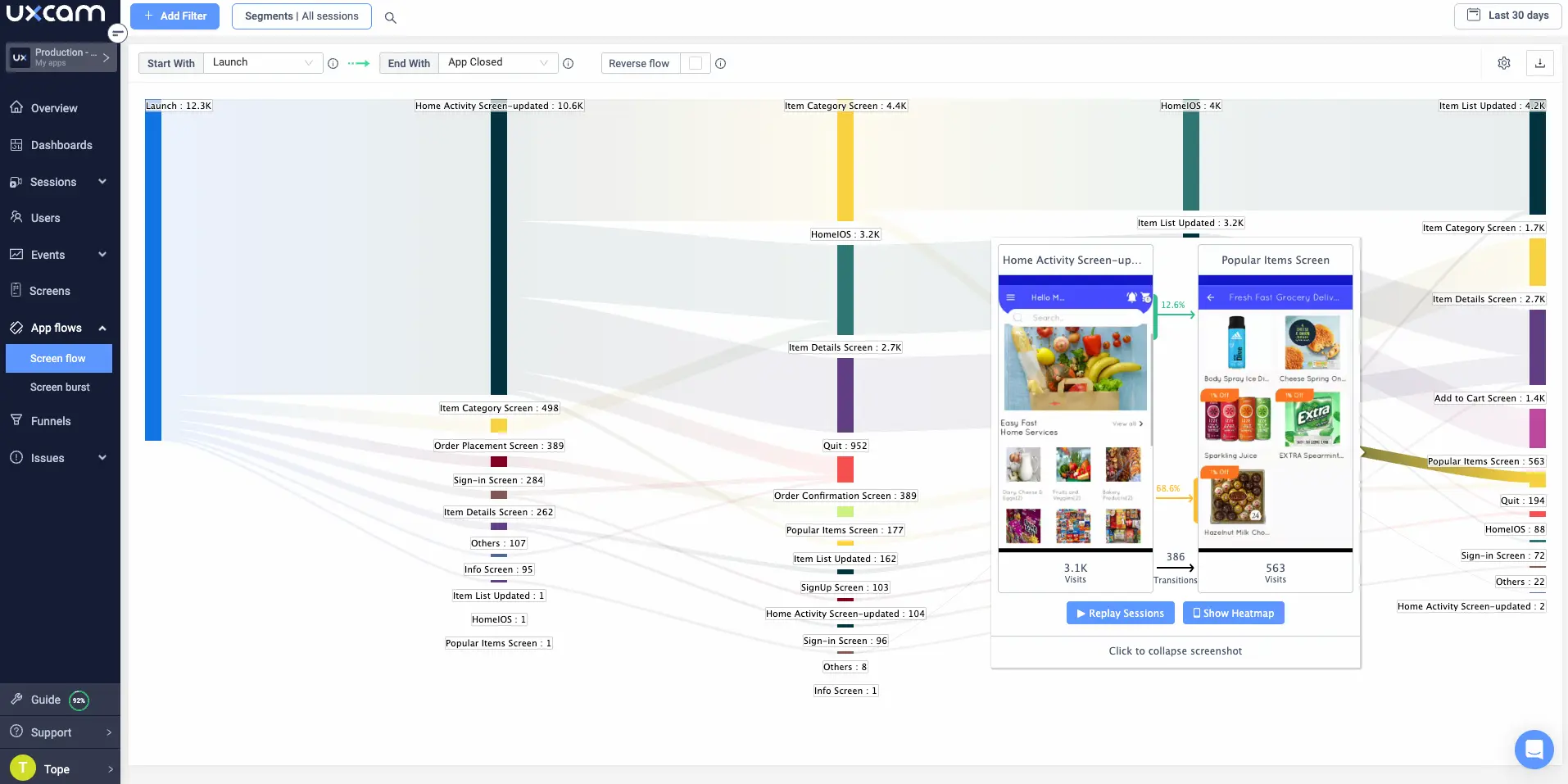
For example, let’s say you notice that lots of users are dropping off right after completing your onboarding flow. Screen flow allows you to see the many paths that these users are taking—by comparing these to the paths taken by users who stick around, you can identify potential areas for improvement in your app’s onboarding process.
3. Segment your customer base
Creating segments is a must if you want to arrive at deeper, more impactful retention insights.
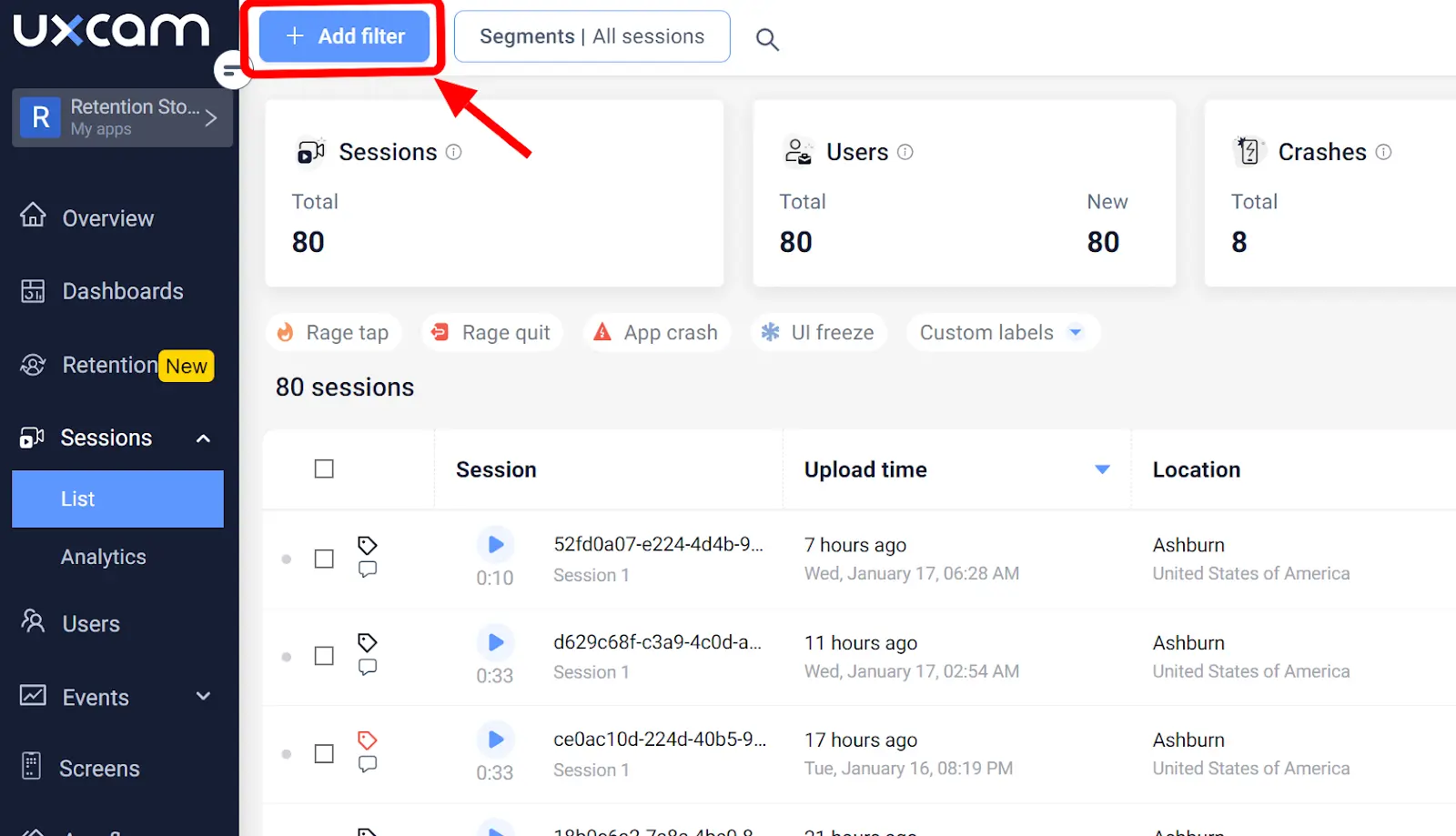
You can create segments in UXCam from any screen or feature—just click the ‘Add Filter’ button and choose any user property, event, or UX issue. Then click ‘Save Segment’ to save the filter for future use.
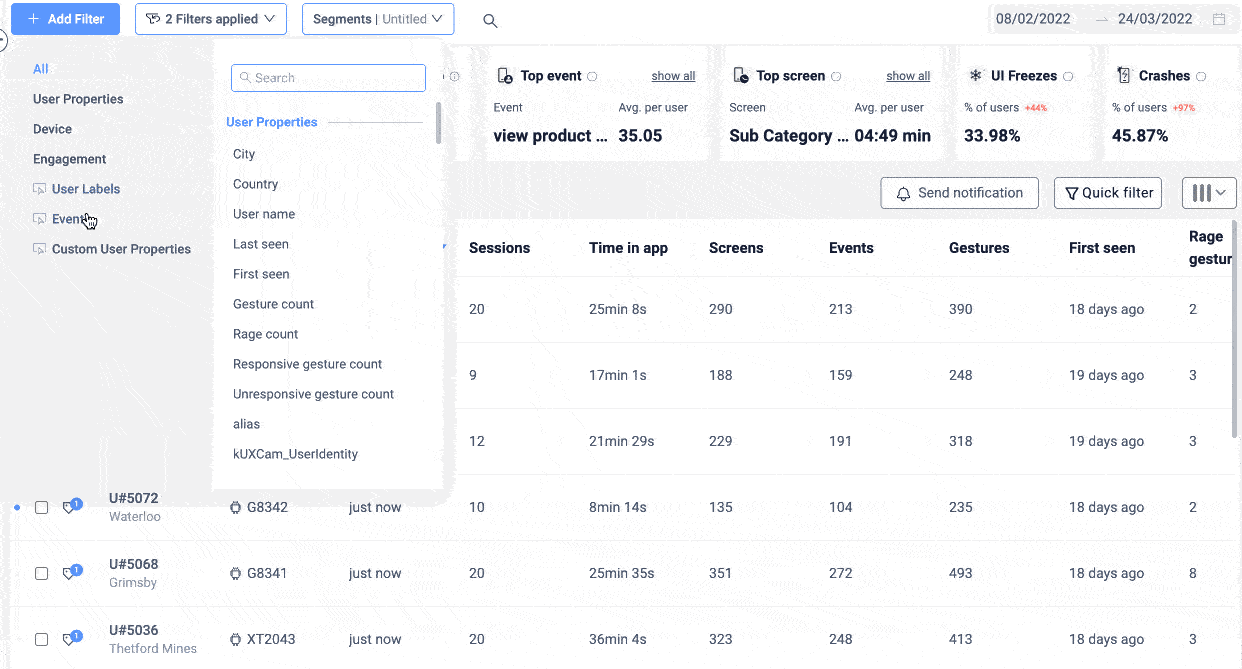
The specific segments you create will depend on your specific business and user base. However, here are some common examples:
New users vs. returning users
High-value vs. low-value users
Demographic segments
Slipping away users
UXCam comes preloaded with many of the most impactful user segments so that you can get started quickly.
4. Conduct surveys and gather feedback
Quantitative data is great, but it often lacks the context that qualitative data can provide. That’s why it’s important to also gather feedback directly from your users.
Surveys are a great way to get a broader understanding of your user base and their behaviors. You can use tools like SurveyMonkey or Google Forms to create surveys and distribute them to your users via email or through in-app pop-ups.
When crafting your survey, be sure to ask open-ended questions that allow for detailed responses rather than simple yes or no answers. This will give you more valuable insights into how your users interact with your product.
Start your advanced customer retention analytics journey
Customer retention analysis gives you the data and insights you need to reliably measure and track how well you’re retaining your customers. By combining both quantitative and qualitative data, you can gain a comprehensive understanding of why your users are leaving or staying with your product.
At UXCam, we arm mobile product teams with a comprehensive set of user behavior and product analytics features—session replays, heatmaps, retention reports, and more. Get started with a free trial and see first-hand how UXCam can help you improve customer retention and drive growth for your mobile app.
You might also be interested in these;
Top 3 customer retention management software tools
Funnel drop-off rates - benchmarks & strategies to improve
Mobile app benchmarks to improve your product strategies
Best ways & tools to do mobile app user behavior analysis
How to increase mobile app engagement
Most important mobile app engagement metrics to track
AUTHOR

Tope Longe
Product Analytics Expert
Ardent technophile exploring the world of mobile app product management at UXCam.
What’s UXCam?
Related articles
App Analytics
Mobile App Tracking: Practical Guide & Best Tools [2026]
The best tracking tools for mobile...

Jonas Kurzweg
Product Analytics Expert
App Analytics
Top Analytics SDKs 2026
Pick the right analytics SDKs to improve your app's...

Jonas Kurzweg
Product Analytics Expert
Product best practices
8 Best UX Analytics Tools and Software We’ve Tested 2025
A good UX design is key when it comes to user satisfaction. Learn about five of the best UX analytics tools you can use to get valuable insights about user...

Jonas Kurzweg
Product Analytics Expert


